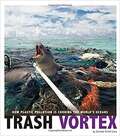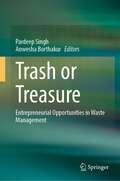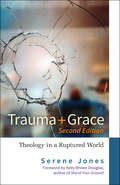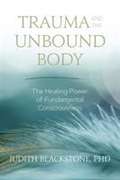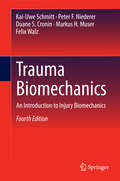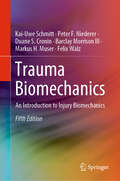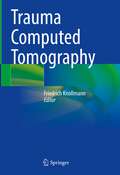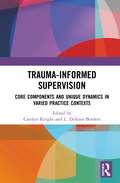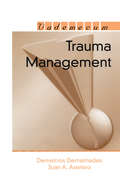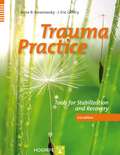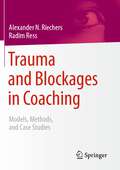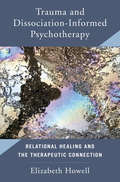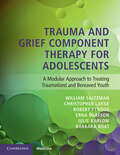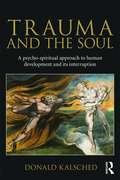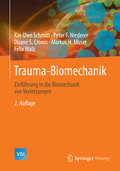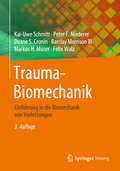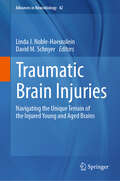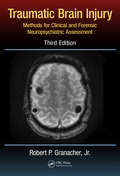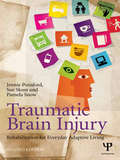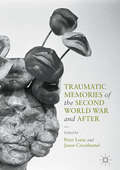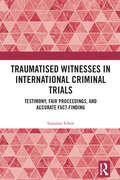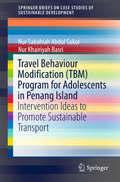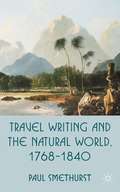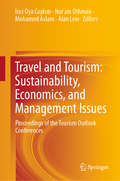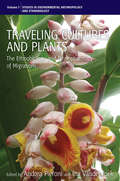- Table View
- List View
Trash Vortex: How Plastic Pollution is Choking the World's Oceans (Captured Science History)
by Danielle Smith-LleraMillions of tons of plastic slip into oceans every year. Some floats and travels slowly with the currents, endangering the health of marine animals. The rest is hardly visible but is far more dangerous. Tiny bits of plastic sprinkle the ocean's surface or mix into the sandy seafloor and beaches. It ends up inside birds, fish, and other animals, harming them-and ultimately humans. Experts struggle with fear and hope as they work to stop the flood of plastic threatening living organisms across the globe.
Trash or Treasure: Entrepreneurial Opportunities in Waste Management
by Pardeep Singh Anwesha BorthakurIn this book, we have contributions from experts working on diverse aspects of waste management and waste entrepreneurship with an aim to contribute toward a holistic understanding of the existing and forthcoming waste handling challenges. Waste entrepreneurship refers to the practice of creating and operating businesses that aim to address the problem of waste management. It signifies businesses that are dedicated to finding innovative solutions for managing waste and plays a crucial role in building a sustainable future. Waste entrepreneurs identify waste as a valuable resource and use state-of-the-art tactics to reduce, reuse, recycle, and re-purpose it. By developing new technologies, services, and products that help reduce waste and recycle materials, they can create new economic opportunities while simultaneously reducing the environmental impact of waste. The primary audience of this book are researchers (from a wide range of disciplinary backgrounds) working in the field of waste management (especially E-waste, Plastics, Paper and Cardboard Waste, Organic Waste, and Construction and Demolition Waste) and environmental sustainability. This book also contains descriptions of various facets of waste entrepreneurship from different countries which will be helpful for different entrepreneurs looking for business opportunities in the waste management sector, NGOs, government agencies, international agencies, and new researchers working in the related fields. In particular, the book could provide start-up ideas to the enthusiastic readers.
Trauma And The Unbound Body: The Healing Power Of Fundamental Consciousness
by Judith Blackstone“Just as an open hand is hidden within a fist, our true nature, with its innate capacities for happiness, love, and wisdom, is hidden within our pain and numbness. Just as we can open a fist to reveal a hand, our unbound, unconstructed being can emerge from our pain and breathe again.” —Dr. Judith Blackstone, Trauma and the Unbound Body Heal trauma. Reclaim your body. Live with wholeness. These are the gifts of utilizing the power of fundamental consciousness—a subtle field of awareness that lies within each of us. In Trauma and the Unbound Body, Dr. Judith Blackstone explores how we can resolve the mental, physical, and emotional struggles of trauma through the power of fundamental consciousness. Dr. Blackstone weaves her 30-plus years of psychotherapy practice to present a simple yet revolutionary approach to healing trauma. She writes, “All of the constrictions in our fascia (the connective tissue surrounding muscles and organs) are moments of our past that we have stopped in their tracks and held in that way, unconsciously. They are frozen moments of our past.” Trauma and the Unbound Body explains how and why the body constricts in response to trauma, causing physical and emotional pain. Dr. Blackstone guides us through step-by-step processes to unwind those constrictions by attuning to fundamental consciousness, setting the body free of trauma once and for all by uncovering an unbreakable, unified ground of being. In Trauma and the Unbound Body, Dr. Blackstone discusses: ? The five main purposes for bodily constriction—and how to release them to return to wholeness ? How to inhabit the body as fundamental consciousness to liberate trauma-based constrictions ? The Realization Process—a meditative practice for embodied spiritual awakening ? Discovering the unified ground of being within the body that enables lasting change
Trauma Biomechanics
by Kai-Uwe Schmitt Peter F. Niederer Duane S. Cronin Markus H. Muser Felix WalzFor the 4th edition of Trauma Biomechanics all existing chapters referring to traffic and sports have been revised and updated. New scientific knowledge and changes in legal defaults (such as norms and standards of crash tests) have been integrated. Additionally one chapter has been added where biomechanical aspects of injuries affected by high energies are communicated in a new way The mechanical basics for ballistics and explosions are described and the respective impacts on human bodies are discussed. The new edition with the additional chapter therefore is addressed to a broader audience than the previous one.
Trauma Biomechanics: Accidental Injury In Traffic And Sports
by Kai-Uwe Schmitt Peter F. Niederer Duane S. Cronin Markus H. Muser Felix Walz Barclay Morrison IIIThis well-established book on injury biomechanics has been extensively revised and expanded for this new edition. It now includes a fundamental treatment of the mechanics at a cellular level, written by the new coauthor Prof. Barclay Morrison III from Columbia University. Furthermore, considerably more attention is paid to computer modeling, and in particular modeling the human body. <P><P> The book addresses a wide range of topics in injury biomechanics, including anatomy, injury classification, injury mechanisms, and injury criteria. Further, it provides essential information on regional injury reference values, or injury criteria, that are either currently in use or proposed by both US and European communities. Although the book is intended as an introduction for doctors and engineers who are newcomers to the field of injury biomechanics, sufficient references are provided for those who wish to conduct further research, and even established researchers will find it useful as a reference guide to the biomechanical background of each proposed injury mechanism and injury criterion.
Trauma Computed Tomography
by Friedrich KnollmannThis book covers the use of computed tomography in trauma care. Over the last two decades, advancements in CT technology have significantly changed the technique and utilization patterns of computed tomography in trauma imaging. This book covers the entire spectrum of this application, structured by organ systems/body areas, corresponding to the subject structure and practice pattern of large academic radiology departments in the US. As a result, the reader benefits from the most advanced currently available sub-specialty expertise in the performance and interpretation of trauma CT studies. The book is intended to serve as an introduction to the subject as well as a reference to the trauma radiologist. Since current post graduate education in radiology does not offer any formally regulated fellowship training in this area, fellowship trained radiologists are typically not trained to cover the entire spectrum of trauma imaging that the practitioner may encounter when covering call assignments, especially outside of highly subspecialized academic medical centers. This book is intended to fill a need to provide subspecialized trauma CT training by integrating contributions from all involved radiology subspecialties in a single volume. This is an ideal guide for radiology residents, fellows, practicing radiologists, trauma surgeons, emergency medicine specialists, surgery residents and fellows, and interested medical students.
Trauma Informed Supervision: Core Components and Unique Dynamics in Varied Practice Contexts
by Carolyn Knight Di BordersSurvivors of trauma are disproportionately represented in agencies providing a broad range of behavioral, social, and mental health services. Practitioners in these settings must understand and be able to respond to survivors of trauma in ways that are empowering, normalize and validate their experiences and reactions, and minimize the risk of retraumatization. Practitioners also will be indirectly traumatized as a result of their work with trauma survivors. <p><p> Practitioners’ ability to help clients with histories of trauma depends upon clinical supervision that is trauma-informed. The trauma-informed supervisor has the dual responsibility of enhancing supervisees’ skills as trauma-informed practitioners and helping them manage the impact their work has on them. <p> Nevertheless, many clinical supervisors only have limited knowledge and training in trauma and may not recognize either the needs of those whom they supervise or the clients their supervisees serve. This book compiles important recommendations from trauma-informed practitioners, supervisors, and researchers who share their professional reflections and personal stories based on their hands-on experiences across mental health and medical contexts.
Trauma Management
by Demetrios Demetriades Juan A. AsensioThis book is a quick and practical guide in the evaluation and management of trauma patients. Contributors include world renowned trauma surgeons, each well-respected for their work and scientific contributions from trauma centers around the world. A trauma reference for years to come, it has as its mission, sharing with all of our colleagues a wea
Trauma Practice, Third Revised and Expanded Edition: Tools For Stabilization And Recovery
by Anna B. Baranowsky J. Eric Gentry<P>An updated, comprehensive, and essential reference and tool-kit for treating trauma survivors. <P>Filled with new resources, this book based on the tri-phasic trauma treatment model is a guide for both seasoned trauma therapists and newer mental health professionals seeking practical approaches that work.
Trauma and Blockages in Coaching: Models, Methods, and Case Studies
by Radim Ress Alexander N. RiechersBlockages to be solved with coaching are often the result of repressed traumatic experiences of a person or their ancestors. Pictorial models will guide the reader into the multi-layered landscape of the soul and its principles. Along the way, the book decodes traumas as the soul’s fundamental building blocks and follows them back to their origins: existential limit-experiences and their common denominator, the splitting of the soul. The consequences of this autonomous survival mechanism affect all areas of life, starting from the unconscious. Therefore, they are not accessible by conventional methods working with the conscious mind. The presented integrative approach provides means and ways that significantly expand the potential of coaching.
Trauma and Dissociation Informed Psychotherapy: Relational Healing And The Therapeutic Connection
by Elizabeth HowellA fresh look at the importance of dissociation in understanding trauma. A new model of therapeutic action, one that heals trauma and dissociation, is overtaking the mental health field. It is not just trauma, but the dissociation of the self, that causes emotional pain and difficulties in functioning. This book discusses how people are universally subject to trauma, what trauma is, and how to understand and work with normative as well as extreme dissociation. In this new model, the client and the practitioner are both traumatized and flawed human beings who affect each other in the mutual process that promotes the healing of the client—psychotherapy. Elizabeth Howell explains the dissociative, relational, and attachment reasons that people blame and punish themselves. She covers the difference between repression and dissociation, and how Freud’s exclusive focus on repression and the one-person fantasy Oedipal model impeded recognition of the serious consequences of external trauma, including child abuse. The book synthesizes trauma/dissociation perspectives and addresses new structural models.
Trauma and Grief Component Therapy for Adolescents
by William Saltzman Christopher M. Layne Robert Pynoos Erna Olafson Julie Kaplow Barbara BoatDeveloped by experts in trauma psychiatry and psychology and grounded in adolescent developmental theory, this is a modular, assessment-driven treatment that addresses the needs of adolescents facing trauma, bereavement, and accompanying developmental disruption. Created by the developers of the University of California, Los Angeles PTSD Reaction Index#65533; and the Persistent Complex Bereavement Disorder Checklist, the book links clinicians with cutting-edge research in traumatic stress and bereavement, as well as ongoing training opportunities. This innovative guide offers teen-friendly coping skills, handouts, and specialized therapeutic exercises to reduce distress and promote adaptive developmental progression. Sessions can be flexibly tailored for group or individual treatment modalities; school-based, community mental health, or private practice settings; and different timeframes and specific client needs. Drawing on multidimensional grief theory, it offers a valuable toolkit for psychologists, psychiatrists, counsellors, and others who work with bereaved and traumatized adolescents. Engaging multicultural illustrations and extensive field-testing give this user-friendly manual international appeal.
Trauma and the Soul: A Psycho-spiritual Approach to Human Development and Its Interruption
by Donald KalschedIn Trauma and the Soul, Donald Kalsched continues the exploration he began in his first book, The Inner World of Trauma (1996)--this time going further into the mystical or spiritual moments that often occur around the intimacies of psychoanalytic work. Through extended clinical vignettes, including therapeutic dialogue and dreams, he shows how depth psychotherapy with trauma's survivors can open both analytic partners to "another world" of non-ordinary reality in which daimonic powers reside, both light and dark. This mytho-poetic world, he suggests, is not simply a defensive product of our struggle with the harsh realities of living as Freud suggested, but is an everlasting fact of human experience--a mystery that is often at the very center of the healing process, and yet at other times, strangely resists it. <P><P> With these "two worlds" in focus, Kalsched explores a variety of themes as he builds, chapter by chapter, an integrated psycho-spiritual approach to trauma and its treatment including: <P><P> images of the lost soul-child in dreams and how this "child" represents an essential core of aliveness that is both protected and persecuted by the psyche's defenses; Dante's guided descent into the Inferno of Hell as a paradigm for the psychotherapy process and its inevitable struggle with self-destructive energies; childhood innocence and its central role in a person's spiritual life seen through the story of St. Exupéry's The Little Prince; how clinical attention to implicit processes in the relational field, as well as discoveries in body-based affective neuroscience are making trauma treatment more effective; the life of C.G. Jung as it portrays his early trauma, his soul's retreat into an inner sanctuary, and his gradual recovery of wholeness through the integration of his divided self. <P><P>This is a book that restores the mystery to psychoanalytic work. It tells stories of ordinary patients and ordinary psychotherapists who, through working together, glimpse the reality of the human soul and the depth of the spirit, and are changed by the experience. Trauma and the Soul will be of particular interest to practicing psychotherapists, psychoanalysts, analytical psychologists, and expressive arts therapists, including those with a "spiritual" orientation. <P><P> Donald Kalsched is a Jungian analyst in private practice in Albuquerque, New Mexico, and a training analyst with the Inter-Regional Society of Jungian Analysts. He is the author of numerous articles in analytical psychology, and lectures widely on the subject of early trauma and its treatment. His books include The Inner World of Trauma (1996).
Trauma-Biomechanik: Einführung in die Biomechanik von Verletzungen (VDI-Buch)
by Kai-Uwe Schmitt Peter F. Niederer Duane S. Cronin Markus H. Muser Felix WalzTrauma-Biomechanik untersucht die Reaktion und Toleranz des menschlichen Körpers auf mechanische Belastungen, die zu Verletzungen führen können. Dabei ist das Verständnis der mechanischen Faktoren, die einen Einfluss auf die Funktionsfähigkeit und die Struktur des Gewebes haben, entscheidend, um Gegenmaßnahmen zur Minderung oder Verhinderung von Verletzungen zu entwickeln.Die Trauma-Biomechanik deckt ein weites Spektrum an Fragestellungen bezüglich Verletzungen ab; namentlich die Klassifikation von Verletzungen, die Verletzungs-Mechanismen und die bekannten Verletzungs-Kriterien. Dieses Buch stellt diese biomechanischen Grundlagen und deren Anwendungen dar. Es behandelt Verletzungen, die im Strassenverkehr und Sport erlitten werden, und geht zudem auf Verletzungen ein, die durch den Einfluss hoher Energien entstehen. Das Buch bietet eine kompakte Darstellung von der Anatomie bis zu ingenieurwissenschaftlichen Ansätzen zur Verletzungsprävention. Dabei wird der in diesem Fachgebiet zweckmässige interdisziplinäre Ansatz verdeutlicht.
Trauma-Biomechanik: Einführung in die Biomechanik von Verletzungen (Vdi-buch Ser.)
by Kai-Uwe Schmitt Peter F. Niederer Duane S. Cronin Markus H. Muser Felix Walz Barclay Morrison IIITrauma-Biomechanik untersucht die Reaktion und Toleranz des menschlichen Körpers auf mechanische Belastungen, die zu Verletzungen führen können. Das Verständnis der mechanischen Faktoren ist entscheidend, um Maßnahmen zur Prävention von Verletzungen zu entwickeln.Dieses Buch stellt die biomechanischen Grundlagen und deren Anwendungen dar. Neben Verletzungen, die im Straßenverkehr und Sport erlitten werden, wird auf ballistische Traumata und Verletzungen durch Explosionen sowie auf Schädigungen durch chronische Belastungen eingegangen. Das Buch bietet eine kompakte Einführung in das Fachgebiet – von zellulärer Biomechanik bis zu ingenieurwissenschaftlichen Ansätzen zur Verletzungsprävention.Der Inhalt• Grundlagen der Trauma-Biomechanik• Überblick über verwendete Methoden, einschließlich Computersimulationen und standardisierter Testverfahren• Systematische Diskussion verschiedener Verletzungen, Verletzungsmechanismen, biomechanischer Kenngrößen und Möglichkeiten der Prävention• Verletzungen durch chronische mechanische Belastung• Aspekte der zellulären Trauma-Biomechanik• Übersicht zur Ballistik und Verletzungen durch Schüsse und ExplosionenDie Zielgruppen• Studierende der Ingenieurwissenschaften, der Gesundheitswissenschaften, der Sportwissenschaften, der Medizin, der biomedizinischen Technik und verwandter Bereiche• Ingenieure, z.B. der Automobil-Industrie• Juristen, Mitarbeitende von Versicherungen und der Unfallforschung
Traumatic Brain Injuries: Navigating the Unique Terrain of the Injured Young and Aged Brains (Advances in Neurobiology #42)
by David M. Schnyer Linda J. Noble-HaeussleinThis book focuses on the clinical and preclinical research on traumatic brain injuries where age at time of injury (young versus aged) reveals both parallel and divergent findings at the molecular, cellular, and behavioral levels with insights into alterations in brain structure and function and the implications for recovery. The authors address the hurdles that have been overcome, consider new directions inspired by the most recent research, and the value of data sharing and evidenced based-practice. Traumatic Brain Injuries: Tackling the Unique Terrain of the Injured Young and Aged Brain explores the challenges imposed by an injury that not only causes tissue damage but disrupts brain development and may incite pathological events in the aging brain. With the proliferation of the research literature in traumatic brain injuries, this is the time for a book that surveys the landscape and assesses where the field is headed and what is needed moving forward.
Traumatic Brain Injury: Methods for Clinical and Forensic Neuropsychiatric Assessment,Third Edition
by Daryl B. Lund Robert P. Granacher Jr.Traumatic Brain Injury: Methods for Clinical and Forensic Neuropsychiatric Assessment, Third Edition provides physicians and psychologists with a scientifically based schema for the clinical evaluation of traumatic brain injury (TBI). The book assists physicians and psychologists in developing treatment plans for patients who have sustained TBIs an
Traumatic Brain Injury: Rehabilitation for Everyday Adaptive Living, 2nd Edition
by Pamela Snow Jennie Ponsford Sue SloanResearch into the rehabilitation of individuals following Traumatic Brain Injury (TBI) in the past 15 years has resulted in greater understanding of the condition. The second edition of this book provides an updated guide for health professionals working with individuals recovering from TBI. Its uniquely clinical focus provides both comprehensive background information, and practical strategies for dealing with common problems with thinking, memory, communication, behaviour and emotional adjustment in both adults and children. The book addresses a wide range of challenges, from those which begin with impairment of consciousness, to those occurring for many years after injury, and presents strategies for maximising participation in all aspects of community life. The book will be of use to practising clinicians, students in health disciplines relevant to neurorehabilitation, and also to the families of individuals with traumatic brain injury.
Traumatic Memories of the Second World War and After
by Peter Leese Jason CrouthamelThis collection investigates the social and cultural history of trauma to offer a comparative analysis of its individual, communal, and political effects in the twentieth century. Particular attention is given to witness testimony, to procedures of personal memory and collective commemoration, and to visual sources as they illuminate the changing historical nature of trauma. The essays draw on diverse methodologies, including oral history, and use varied sources such as literature, film and the broadcast media. The contributions discuss imaginative, communal and political responses, as well as the ways in which the later welfare of traumatized individuals is shaped by medical, military, and civilian institutions. Incorporating innovative methodologies and offering a thorough evaluation of current research, the book shows new directions in historical trauma studies.
Traumatised Witnesses in International Criminal Trials: Testimony, Fair Proceedings, and Accurate Fact-Finding
by Suzanne SchotThis book focuses on the testimonial evidence of traumatised witnesses in trials of international crimes, which deal with acts of genocide, war crimes and crimes against humanity. Such trials often involve the testimonies of those who experienced or witnessed extremely traumatic events, which can make it hard for these witnesses to recall specific details. Testifying during trial may in itself also pose challenges to their well-being. Yet the legal process of determining whether someone can be held criminally responsible for the alleged crimes needs to be fair, in accordance with the right to a fair trial of the accused, and the facts need to be determined as accurately as possible. This book argues that to ensure fair and accurate fact-finding when in particular traumatised witnesses testify, a balance needs to be struck between the needs of witnesses who testify about traumatic experiences, the fair trial rights of the accused and the objective of the court to establish as accurately as possible the responsibility of the accused. This is crucial throughout the stages of selecting, preparing, presenting and assessing the testimonial evidence of traumatised witnesses. The methodology involves an analysis of transcripts of proceedings and case law of the International Criminal Tribunal for the former Yugoslavia, the International Criminal Court and Dutch courts prosecuting international crimes. The research demonstrates that it is often difficult to strike a balance between the competing objectives during proceedings when traumatised witnesses testify due to the current lack of regulations and guidelines applicable during investigations and prosecutions. This book shows that this balance can, and should, be achieved when traumatised witnesses testify during criminal proceedings for international crimes. The work is an invaluable resource for researchers, academics and practitioners in criminal law, criminology, legal psychology, legal psychiatry, social anthropology and forensic sciences.
Travel Behaviour Modification: Intervention Ideas to Promote Sustainable Transport (Springerbriefs On Case Studies Of Sustainable Development Ser.)
by Nur Khairiyah Basri Nur Sabahiah SukorThis book discusses the potential of travel behaviour modification (TBM) as a persuasive tool to promote low-carbon mobility among adolescents on Penang Island by highlighting the role of bus usage in a sustainable urban lifestyle. The participants of the Reduce Carbon Footprint Campaign, which aimed to create sustainable transport and pro-environmental awareness among adolescents, were recruited from secondary schools on Penang Island. Campaign materials, such as bus routes maps and discount travel cards for students, were provided by Rapid Penang, the leading bus operator in Penang. The campaign also involved several intervention programmes, including motivational sessions and classes for travel journey planning.
Travel Writing and the Natural World, 1768–1840
by Paul SmethurstTaking as a starting point the parallel occurrence of Cook's Pacific voyages, the development of natural history, scenic tourism in Britain, and romantic travel in Europe, this book argues that the effect of these practices was the production of nature as an abstract space and that the genre of travel writing had a central role in reproducing it.
Travel and Tourism: Proceedings of the Tourism Outlook Conferences
by Alan Lew İnci Oya Coşkun Nor’ain Othman Mohamed AslamThis book contains the best papers on tourism sustainability, economics and management presented at the 10th Tourism Outlook Conference, held in Sri Lanka from 19 to 21 October 2017 and the 11th Tourism Outlook Conference held in Eskişehir, Turkey from 3-5 October 2018. The papers provide a distinctly multidisciplinary perspective that brings together experts in the fields of management, economics and tourism to develop and disseminate solutions to emerging issues and challenges related to sustainable tourism and community development.The book provides a platform for cross-disciplinary dialogues that integrate different research and knowledge from diverse geographical, sectoral, and institutional perspectives. Through this approach, readers gain new perspectives to expand their skills and advance their studies and applications in the sustainable development of tourism resources and destinations, especially in developing world contexts.
Traveling Cultures And Plants
by Andrea Pieroni Ina VandebroekThe tremendous increase in migrations and diasporas of human groups in the last decades are not only bringing along challenging issues for society, especially related to the economic and political management of multiculturalism and culturally effective health care, but they are also creating dramatic changes in traditional knowledge, believes and practices (KBP) related to (medicinal) plant use. The contributors to this volume - all internationally recognized scholars in the field of ethnobiology, transcultural pharmacy, and medical anthropology - analyze these dynamics of traditional knowledge in especially 12 selected case studies. Ina Vandebroek, features in Nova's "Secret Life of Scientists", answering the question: just what is ethnobotany?
